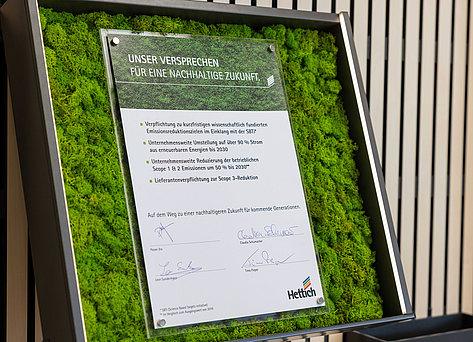Skupina Hettich se zavazuje k práci na vědecky podložených klimatických cílech

„V souladu s mottem „Konej dnes, mysli na zítřek“ jsme v Hettichu převzali zodpovědnost za svět, ve kterém žijeme. Podpis dohody SBTi je důležitým milníkem pro naši společnost a podtrhuje naši zodpovědnost za budoucí generace,“ vysvětluje Timo Pieper, jednatel skupiny Hettich. „Jsme přesvědčení, že nastavením jasných, vědecky podložených cílů, můžeme snížit svoji uhlíkovou stopu, podpořit inovace a pozitivně přispět k ochraně klimatu,“ dodává Pavan Jha, manažer udržitelnosti skupiny Hettich.
Závazek k jasným cílům a udržitelným procesům
Připojením se k iniciativě SBTi se Hettich zavazuje k následujícím opatřením:
- 50% redukce emisí v Scope 1 & 2 do roku 2030
- Využívání energie z obnovitelných zdrojů z 90 % do roku 2030
- Spolupráce s celým dodavatelským řetězcem na jeho závazku k redukci emisí v Scope 3
Certifikát byl podepsán jménem všech kolegyň a kolegů skupiny Hettich na letošní tiskové konferenci.
O iniciativě Science Based Targets (SBTi)
Iniciativa Science Based Targets (SBTi) je organizace zabývající se klimatickými opatřeními, která umožňuje společnostem a finančním institucím po celém světě podílet se na boji proti klimatické krizi. Partnerskými organizacemi, které napomohly růstu a rozvoji SBTi, jsou CDP, Globální kompakt OSN, koalice We Mean Business, Světový institut pro zdroje (WRI) a Světový fond pro ochranu přírody (WWF). SBTi vyvíjí standardy, nástroje a pokyny, které umožňují společnostem stanovit cíle pro snížení emisí skleníkových plynů v souladu s tím, co je nutné k udržení globálního oteplování pod katastrofickou úrovní a dosažení nulových emisí nejpozději do roku 2050.
Galerie
Všechny obrázky
Všechny mediální soubory
Skupina Hettich se zavazuje k práci na vědecky podložených klimatických cílech
Skupina Hettich se zavazuje k práci na vědecky podložených klimatických cílech







